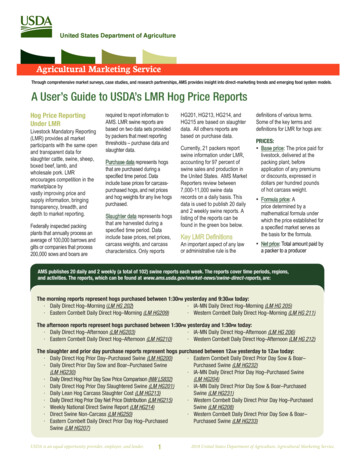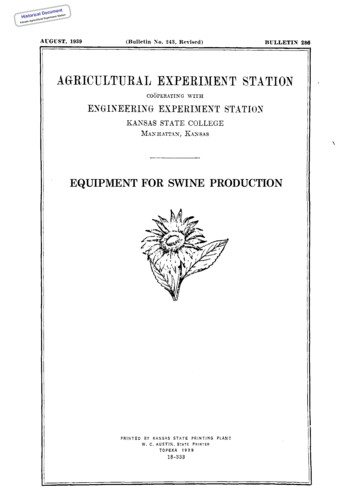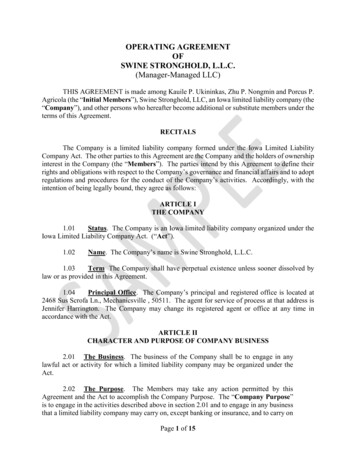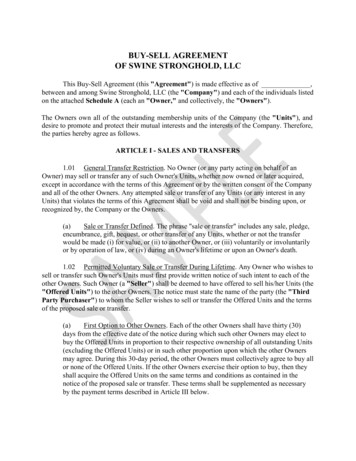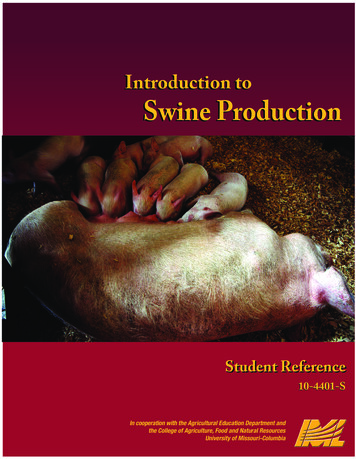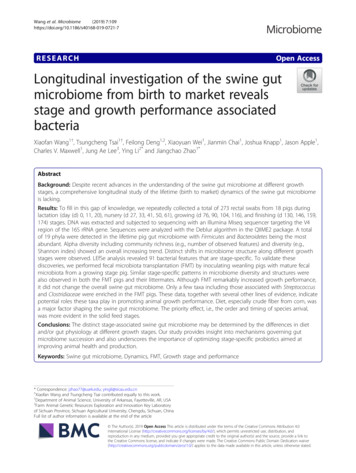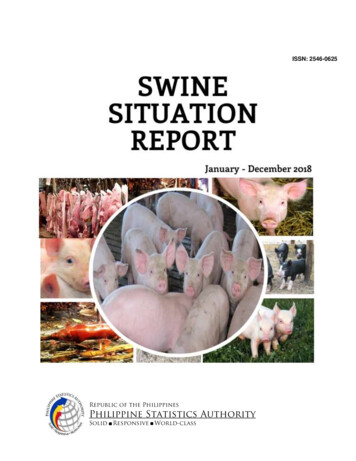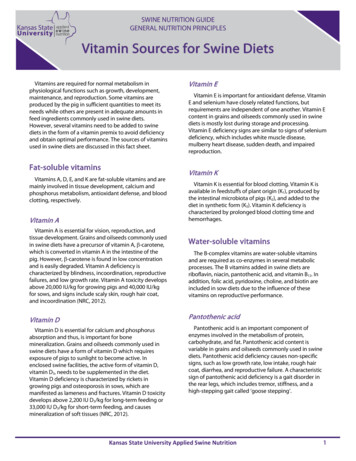
Transcription
SWINE NUTRITION GUIDEGENERAL NUTRITION PRINCIPLESVitamin Sources for Swine DietsVitamins are required for normal metabolism inphysiological functions such as growth, development,maintenance, and reproduction. Some vitamins areproduced by the pig in sufficient quantities to meet itsneeds while others are present in adequate amounts infeed ingredients commonly used in swine diets.However, several vitamins need to be added to swinediets in the form of a vitamin premix to avoid deficiencyand obtain optimal performance. The sources of vitaminsused in swine diets are discussed in this fact sheet.Fat-soluble vitaminsVitamins A, D, E, and K are fat-soluble vitamins and aremainly involved in tissue development, calcium andphosphorus metabolism, antioxidant defense, and bloodclotting, respectively.Vitamin AVitamin A is essential for vision, reproduction, andtissue development. Grains and oilseeds commonly usedin swine diets have a precursor of vitamin A, b-carotene,which is converted in vitamin A in the intestine of thepig. However, b-carotene is found in low concentrationand is easily degraded. Vitamin A deficiency ischaracterized by blindness, incoordination, reproductivefailures, and low growth rate. Vitamin A toxicity developsabove 20,000 IU/kg for growing pigs and 40,000 IU/kgfor sows, and signs include scaly skin, rough hair coat,and incoordination (NRC, 2012).Vitamin EVitamin E is important for antioxidant defense. VitaminE and selenium have closely related functions, butrequirements are independent of one another. Vitamin Econtent in grains and oilseeds commonly used in swinediets is mostly lost during storage and processing.Vitamin E deficiency signs are similar to signs of seleniumdeficiency, which includes white muscle disease,mulberry heart disease, sudden death, and impairedreproduction.Vitamin KVitamin K is essential for blood clotting. Vitamin K isavailable in feedstuffs of plant origin (K1), produced bythe intestinal microbiota of pigs (K2), and added to thediet in synthetic form (K3). Vitamin K deficiency ischaracterized by prolonged blood clotting time andhemorrhages.Water-soluble vitaminsThe B-complex vitamins are water-soluble vitaminsand are required as co-enzymes in several metabolicprocesses. The B vitamins added in swine diets areriboflavin, niacin, pantothenic acid, and vitamin B12. Inaddition, folic acid, pyridoxine, choline, and biotin areincluded in sow diets due to the influence of thesevitamins on reproductive performance.Pantothenic acidVitamin DVitamin D is essential for calcium and phosphorusabsorption and thus, is important for bonemineralization. Grains and oilseeds commonly used inswine diets have a form of vitamin D which requiresexposure of pigs to sunlight to become active. Inenclosed swine facilities, the active form of vitamin D,vitamin D3, needs to be supplemented in the diet.Vitamin D deficiency is characterized by rickets ingrowing pigs and osteoporosis in sows, which aremanifested as lameness and fractures. Vitamin D toxicitydevelops above 2,200 IU D3/kg for long-term feeding or33,000 IU D3/kg for short-term feeding, and causesmineralization of soft tissues (NRC, 2012).Pantothenic acid is an important component ofenzymes involved in the metabolism of protein,carbohydrate, and fat. Pantothenic acid content isvariable in grains and oilseeds commonly used in swinediets. Pantothenic acid deficiency causes non-specificsigns, such as low growth rate, low intake, rough haircoat, diarrhea, and reproductive failure. A characteristicsign of pantothenic acid deficiency is a gait disorder inthe rear legs, which includes tremor, stiffness, and ahigh-stepping gait called ‘goose stepping’.Kansas State University Applied Swine Nutrition1
RiboflavinCholineRiboflavin is an essential component of enzymesinvolved in the metabolism of protein, carbohydrate, andfat. Riboflavin content is typically low in grains andoilseeds commonly used in swine diets. Riboflavindeficiency causes non-specific signs, such as low growthrate, low intake, skin lesions, rough hair coat, diarrhea,and reproductive failure.Choline is mainly added to sow diets. Choline isinvolved in many essential metabolic functions for cellstructure, nervous function, and amino acid metabolism.Choline is present in adequate amounts in grains andoilseeds commonly used in swine diets and pigs are alsoable to produce choline to meet the requirements.Choline supplementation in sows is found to improveconception rate, farrowing rate, litter size, live bornpiglets, and weaned piglets.NiacinNiacin is an important component of enzymesinvolved in many metabolic reactions. Grains commonlyused in swine diets contain adequate amounts of niacin,but in a bound form unavailable to pigs. Niacindeficiency is characterized by skin lesions, rough haircoat, hair loss, diarrhea, vomiting, and lesions in thedigestive tract.Vitamin B12Vitamin B12 is an essential component of enzymesinvolved in several metabolic functions. Feedstuffs ofplant origin do not contain vitamin B12, whereas proteinsof animal origin are good sources of vitamin B12. VitaminB12 deficiency causes non-specific signs, such as lowgrowth rate, low intake, rough hair coat, incoordination,and reproductive failure. A typical sign of vitamin B12deficiency is anemia.Folic acidFolic acid is mainly added to sow diets. Folic acid isinvolved in the synthesis of essential components for celldevelopment and function. Grains and oilseedscommonly used in swine diets have adequateconcentration of folic acid to meet the requirement ofgrowing pigs. Folic acid supplementation in sows isparticularly important for adequate development ofconceptus and to improve litter size and live bornpiglets.BiotinBiotin is mainly added to sow diets. Biotin is anessential component of enzymes involved in themetabolism of protein, carbohydrate, and fat. Grains andoilseeds commonly used in swine diets have adequateconcentration of biotin to meet the requirement ofgrowing pigs. Biotin supplementation in sows is found toimprove litter size, live born piglets, and weaned piglets,and to enhance hoof soundness.KSU Vitamin premixA suggested vitamin premix is available at KSUPremix & Diet Recommendations. This singlepremix can be used in diets for all stages ofproduction by adjusting the inclusion rate for sow,nursery, grower, and finisher diets. A sow add packis also available for sow diets to supply the specificvitamins to enhance reproduction.Vitamins can be combined with trace minerals in aVTM premix, but it is recommended to haveseparate premixes because trace minerals can affectthe vitamin stability. Otherwise, VTM premix agemust be monitored to ensure it is used beforeexcess vitamin loss.PyridoxinePyridoxin is mainly added to sow diets. Pyridoxine is anessential component of enzymes involved in amino acidmetabolism. Grains and oilseeds commonly used inswine diets have adequate concentration of pyridoxineto meet the requirement of growing pigs. Pyridoxinesupplementation in sows is found to improve litter sizeand wean-to-estrus interval.Kansas State University Applied Swine Nutrition2
Vitamin sourcesFactors affecting vitamin stabilitySynthetic vitamins are widely used in premixes forswine diets. The commercially synthesized vitamins aremodified from natural vitamin forms to improve theirstability, compatibility, mixability, and handlingcharacteristics for feed supplementation. The naturalsource of vitamin E, d-α-tocopheryl acetate or naturalvitamin E, is the only non-synthetic vitamin often used inswine diets. A list of sources of vitamins and respectiveunits of activity is presented in Table 1.Vitamin stability in premixes is affected by exposure tolight, heat, moisture, oxygen, and pH, and contact withother compounds. These factors subject vitamins todegradation primarily through oxidation. The long-termor multiple exposure to these factors generally magnifiesthe negative impact on vitamin stability. The individualvitamins vary in their susceptibility to degradation (Table2). In general, the most sensitive or labile vitamins arevitamin K3, vitamin A, pyridoxine, vitamin B12, and folicacid (Shurson et al., 2011).The form of vitamin products determines importantcharacteristics of vitamin quality. Vitamin forms withgood stability are usually able to maintain good vitaminbioavailability. Vitamin forms with high flowability, highuniformity in mix, low dusting, and low caking provideoptimal handling and mixing characteristics. Altogether,these characteristics are important because vitamins areadded in such small amounts to swine diets that thepresence or absence of vitamins in individual rationsmarkedly affect performance and health.Vitamin levelsThe vitamin content of feed ingredients is usuallydisregarded in diet formulation because of imprecisionand variation on methods of analysis, characteristics ofingredients, and degradation of vitamins in storage andprocessing (Gaudré and Quiniou, 2009). Thus, vitaminlevels in the vitamin premix are calculated to fully supplythe vitamin requirements of swine. Also, it appears to bestandard practice to add a margin of safety for vitaminlevels beyond the NRC (2012) requirement estimates(Flohr et al., 2016). The margin of safety intends toaccount for fluctuations in daily feed consumption anddegradation of vitamins in storage and processing.Vitamin stabilityThe stability of vitamins in a premix is critical inmaintaining vitamin potency. Susceptibility todegradation varies depending on individual vitaminsand on a number of factors that affect vitamin stability.Safety margins for vitamin premix formulation areusually based upon vitamin cost, presence or absence oftrace minerals and choline in the premix, feed processingcharacteristics, environmental conditions, anticipatedstorage time, and expected rates of vitamin potencylosses (Shurson et al., 2011).Vitamin stability in premixesPremix composition affects vitamin stability, especiallywith regard to the presence or absence of choline andinorganic trace minerals. To maintain vitamin potency itis recommended to have vitamin premixes separatedfrom choline and trace mineral premixes.Choline is very hygroscopic and absorbs significantamounts of moisture from the environment, whichaffects the stability of other vitamins when added in thepremix. Inorganic trace minerals also affect the stabilityof vitamins when added in the premix, as trace mineralsoften produce reduction and oxidation reactions in thepremix. Among the inorganic trace mineral sources, thesulfates have greater effect on vitamin stability thancarbonates and oxides. Use of organic trace mineralsources reduces vitamin activity losses by 40 to 50%during storage compared to adding inorganic traceminerals in a vitamin-trace mineral premix (Shurson etal., 2011).Vitamin stability during feed processingSome processes used in feed manufacturing affectvitamin stability (Reddy and Love, 1999). In swine diets,pelleting is typically the most aggressive process againstvitamins due to exposure to heat, moisture, pressure,and abrasion. Mixing also affects vitamin stability due toabrasion and contact with other compounds in the diet.Vitamin stability during storageVitamins are rather stable prior to preparation of apremix and remain reasonably stable in complete feeds.Consequently, most vitamin losses occur while thevitamin premix is under storage. Both storage time andstorage conditions should be controlled for vitaminpremixes. Vitamin premixes should be stored in a dry,Kansas State University Applied Swine Nutrition3
cool, and dark place to maintain stability during storage.Also, the use of barriers such as plastic-lined bags aid inreducing the absorption of moisture.Premixes containing vitamins exclusively can be storedfor about 3 to 4 months. However, storage time shouldnot exceed 60 days if choline and trace minerals arepresent in combination with vitamins in the premix.During storage, vitamin potency can be monitored inpremixes through a vitamin activity assay. Vitamin assaycosts are generally expensive, which prompts theselection of one indicator vitamin to estimate thevitamin potency losses in the premix. According toShurson et al. (2011), retinol appears to be the bestindicator in the vitamin premix because of the low costof assay, relatively high sensitivity of vitamin A tomultiple factors, and high expected loss of activity permonth of storage.Technologies to improve vitamin stabilityAdvances in research and technology have led to thedevelopment of specialized vitamin forms to providesuperior vitamin stability. Many commercial vitaminmanufacturers have succeeded in enhancing stability ofvitamins with spray-drying and beadlet technologies(DSM Vitamin Nutrition Compendium).Spray-dried vitamin products are manufactured as afine powder with high stability and good uniformity ofmix, but only fair quality in terms of flowability,dustiness, and caking. Beadlets are produced by coatingvitamins in gelatin or starch to prevent contact withfactors affecting vitamin stability until it is digested bythe pig. Beadlets are manufactured as a fine granularproduct with high stability and also high flowability, lowdustiness, and low caking characteristics. Cross-linkedbeadlets are produced by coating vitamins with crosslinked gelatin proteins, which makes harder beadletsthat are more resistant to the pressure and abrasion ofpelleting. The inclusion of antioxidants in the beadletsprovide additional protection against oxidative factors.ReferencesDSM Vitamin Nutrition Compendium. Vitamin stability.Available at:https://www.dsm.com/markets/anh/en US/Compendium.htmlFlohr, J. R., J. M. DeRouchey, J. C. Woodworth, M. D. Tokach,R. D. Goodband, and S. S. Dritz. 2016. A survey of currentfeeding regimens for vitamins and trace minerals in the USswine industry. Journal of Swine Health and Production.24:290–303.Gaudré, D., and N. Quiniou. 2009. What mineral and vitaminlevels to recommend in swine diets? Revista Brasileira deZootecnia. 38:190-200. doi:10.1590/S151635982009001300019National Research Council. 2012. Nutrient Requirements ofSwine. 11th Revised Edition. The National Academies Press,Washington, DC. doi:10.17226/13298Reddy, M.B., and M. Love. 1999. The impact of foodprocessing on the nutritional quality of vitamins and minerals.Advances in Experimental Medicine and Biology. 459:99-106.doi:10.1007/978-1-4615-4853-9 7Reese, D. E., and G. M. Hill. 2010. Trace minerals and vitaminsfor swine diets. National Swine Nutrition Guide. PIG 07-02-06.Shelton, N. W., S. S. Dritz, J. L. Nelssen, M. D. Tokach, R. D.Goodband, J. M. DeRouchey, H. Yang, D. A. Hill, D. Holzgraefe,D. H. Hall, and D. C. Mahan. 2014. Effects of dietary vitamin Econcentration and source on sow, milk, and pig concentrationsof α-tocopherol. Journal of Animal Science. 92:4547–4556.doi:10.2527/jas.2014-7311Shurson, G. C, T. M. Salzer, D. D. Koehler, and M. H. Whitney.2011. Effect of metal specific amino acid complexes andinorganic trace minerals on vitamin stability in premixes.Animal Feed Science and Technology. nsas State University Applied Swine Nutrition4
Table 1. Sources of vitamins and respective units of activityVitaminAbbreviation Principal compoundSourceVitamin AARetinolRetinyl acetateRetinyl A palmitateRetinyl A propionateVitamin DVitamin EDECholecalciferol (D3)α-tocopherolCholecalciferol (vitamin D3)dl-α-tocopheryl acetated-α-tocopheryl acetate (natural vitamin E)dl-α-tocopherold-α-tocopherolVitamin KKMenadione (K3)Menadione nicotinamide bisulfite (MNB)Menadione dimethylpyrimidinol bisulfite (MPB)RiboflavinNiacinB2B3PantothenicacidVitamin B12PyridoxineCholineBiotinFolic acidB5RiboflavinNiacinamide and nicotinicacidPantothenic acidMenadione sodium bisulfite complex (MSBC)Crystalline riboflavinNiacinamideNicotinic acidd-calcium pantothenatedl-calcium otinPteroyglutamic acid andpolyglutamate derivativesCyanocobalaminPyridoxine hydrochlorideCholine chlorided-biotinFolic acidUnits of activity1 IU 0.34 μg retinyl acetate1 IU 0.55 μg retinyl palmitate1 IU 0.36 μg retinyl propionate1 IU 0.025 μg cholecalciferol1 mg 1.0 IU dl-α-tocopheryl acetate1 mg 2.1 IU d-α-tocopheryl acetate11 mg 1.11 IU dl-α-tocopherol1 mg 1.49 IU d-α-tocopherol1 Ansbacher unit 20 Dam units 0.0008 mg menadioneCommonly expressed as mgCommonly expressed as mgCommonly expressed as mg1 mg 0.92 mg d-pantothenic acid1 mg 0.45 mg d-pantothenic acid1 μg 1 USP unit 11,000 LLD units1 mg 0.823 mg pyridoxine1 mg 0.868 mg choline1 mg 1 mg of activity1 mg 1 mg of activityAdapted from Reese and Hill (2010) and 1Shelton et al. (2014). The vitamin sources listed in italic are less commonly used sources.Kansas State University Applied Swine Nutrition5
Table 2. Susceptibility of vitamins to factors affecting amin AAVery sensitiveSensitiveVitamin DDSensitiveSensitiveVitamin EEStableStableVitamin KKSensitiveVery StablePantothenic acidB5SensitiveSensitiveVitamin B12B12Very sensitiveSensitivePyridoxineB6Very sensitiveSensitiveBiotinHSensitiveStableFolic acidBcVery sensitiveSensitiveLightVery ableSensitiveSensitiveStableVery sensitiveOxygenVery sensitiveVery tiveStableStableStableAcid pHSensitiveSensitiveSensitiveVery ry sensitiveAlkaline bleStableStableStableAdapted from DSM Vitamin Nutrition Compendium and Shurson et al. (2011).Kansas State University Applied Swine NutritionCite as: Menegat, Mariana B., Robert D. Goodband, Joel M. DeRouchey, Mike D. Tokach, Jason C. Woodworth, and Steve S. Dritz. 2019.Kansas State University Swine Nutrition Guide: Vitamin Sources for Swine Diets.6
3, needs to be supplemented in the diet. Vitamin D deficiency is characterized by rickets in growing pigs and osteoporosis in sows, which are manifested as lameness and fractures. Vitamin D toxicity develops above 2,200 IU D 3/kg for long-term feeding or 33,000 IU D 3/kg for short-term feeding, and causes mineralization of soft tissues (NRC, 2012).

